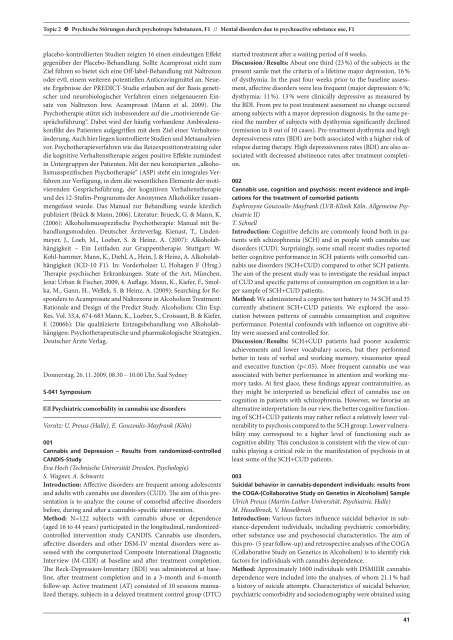Psychische Erkrankungen in der Lebensspanne ... - DGPPN
Psychische Erkrankungen in der Lebensspanne ... - DGPPN
Psychische Erkrankungen in der Lebensspanne ... - DGPPN
Erfolgreiche ePaper selbst erstellen
Machen Sie aus Ihren PDF Publikationen ein blätterbares Flipbook mit unserer einzigartigen Google optimierten e-Paper Software.
Topic 2 G <strong>Psychische</strong> Störungen durch psychotrope Substanzen, F1 // Mental disor<strong>der</strong>s due to psychoactive substance use, F1<br />
placebo-kontrollierten Studien zeigten 16 e<strong>in</strong>en e<strong>in</strong>deutigen Effekt<br />
gegenüber <strong>der</strong> Placebo-Behandlung. Sollte Acamprosat nicht zum<br />
Ziel führen so bietet sich e<strong>in</strong>e Off-label-Behandlung mit Naltrexon<br />
o<strong>der</strong> evtl. e<strong>in</strong>em weiteren potentiellen Anticrav<strong>in</strong>gmittel an. Neueste<br />
Ergebnisse <strong>der</strong> PREDICT-Studie erlauben auf <strong>der</strong> Basis genetischer<br />
und neurobiologischer Verfahren e<strong>in</strong>en zielgenaueren E<strong>in</strong>satz<br />
von Naltrexon bzw. Acamprosat (Mann et al. 2009). Die<br />
Psychotherapie stützt sich <strong>in</strong>sbeson<strong>der</strong>e auf die „motivierende Gesprächsführung“.<br />
Dabei wird <strong>der</strong> häufig vorhandene Ambivalenzkonflikt<br />
des Patienten aufgegriffen mit dem Ziel e<strong>in</strong>er Verhaltensän<strong>der</strong>ung.<br />
Auch hier liegen kontrollierte Studien und Metaanalysen<br />
vor. Psychotherapieverfahren wie das Reizexpositionstra<strong>in</strong><strong>in</strong>g o<strong>der</strong><br />
die kognitive Verhaltenstherapie zeigen positive Effekte zum<strong>in</strong>dest<br />
<strong>in</strong> Untergruppen <strong>der</strong> Patienten. Mit <strong>der</strong> neu konzipierten „alkoholismusspezifischen<br />
Psychotherapie“ (ASP) steht e<strong>in</strong> <strong>in</strong>tegrales Verfahren<br />
zur Verfügung, <strong>in</strong> dem die wesentlichen Elemente <strong>der</strong> motivierenden<br />
Gesprächsführung, <strong>der</strong> kognitiven Verhaltenstherapie<br />
und des 12-Stufen-Programms <strong>der</strong> Anonymen Alkoholiker zusammengefasst<br />
wurde. Das Manual zur Behandlung wurde kürzlich<br />
publiziert (Brück & Mann, 2006). Literatur: Brueck, G. & Mann, K.<br />
(2006): Alkoholismusspezifische Psychotherapie: Manual mit Behandlungsmodulen.<br />
Deutscher Ärzteverlag. Kienast, T., L<strong>in</strong>denmeyer,<br />
J., Loeb, M., Loeber, S. & He<strong>in</strong>z, A. (2007): Alkoholabhängigkeit<br />
– E<strong>in</strong> Leitfaden zur Gruppentherapie. Stuttgart: W.<br />
Kohl-hammer. Mann, K., Diehl, A., He<strong>in</strong>, J. & He<strong>in</strong>z, A. Alkoholabhängigkeit<br />
(ICD-10 F1). In: Vor<strong>der</strong>holzer U, Hohagen F (Hrsg.)<br />
Therapie psychischer <strong>Erkrankungen</strong>. State of the Art, München,<br />
Jena: Urban & Fischer, 2009, 4. Auflage. Mann, K., Kiefer, F., Smolka,<br />
M., Gann, H., Wellek, S. & He<strong>in</strong>z, A. (2009): Search<strong>in</strong>g for Respon<strong>der</strong>s<br />
to Acamprosate and Naltrexone <strong>in</strong> Alcoholism Treatment:<br />
Rationale and Design of the Predict Study. Alcoholism: Cl<strong>in</strong> Exp.<br />
Res. Vol. 33,4, 674-683 Mann, K., Loeber, S., Croissant, B. & Kiefer,<br />
F. (2006b): Die qualifizierte Entzugsbehandlung von Alkoholabhängigen:<br />
Psychotherapeutische und pharmakologische Strategien.<br />
Deutscher Ärzte Verlag.<br />
Donnerstag, 26. 11. 2009, 08.30 – 10.00 Uhr, Saal Sydney<br />
S-041 Symposium<br />
Psychiatric comorbidity <strong>in</strong> cannabis use disor<strong>der</strong>s<br />
Vorsitz: U. Preuss (Halle), E. Gouzoulis-Mayfrank (Köln)<br />
001<br />
Cannabis and Depression – Results from randomized-controlled<br />
CANDIS-Study<br />
Eva Hoch (Technische Universität Dresden, Psychologie)<br />
S. Wagner, A. Schwartz<br />
Introduction: Affective disor<strong>der</strong>s are frequent among adolescents<br />
and adults with cannabis use disor<strong>der</strong>s (CUD). The aim of this presentation<br />
is to analyze the course of comorbid affective disor<strong>der</strong>s<br />
before, dur<strong>in</strong>g and after a cannabis-specific <strong>in</strong>tervention.<br />
Method: N=122 subjects with cannabis abuse or dependence<br />
(aged 16 to 44 years) participated <strong>in</strong> the longitud<strong>in</strong>al, randomizedcontrolled<br />
<strong>in</strong>tervention study CANDIS. Cannabis use disor<strong>der</strong>s,<br />
affective disor<strong>der</strong>s and other DSM-IV mental disor<strong>der</strong>s were assessed<br />
with the computerized Composite International Diagnostic<br />
Interview (M-CIDI) at basel<strong>in</strong>e and after treatment completion.<br />
The Beck-Depression-Inventary (BDI) was adm<strong>in</strong>istered at basel<strong>in</strong>e,<br />
after treatment completion and <strong>in</strong> a 3-month and 6-month<br />
follow-up. Active treatment (AT) consisted of 10 sessions manualized<br />
therapy, subjects <strong>in</strong> a delayed treatment control group (DTC)<br />
started treatment after a wait<strong>in</strong>g period of 8 weeks.<br />
Discussion / Results: About one third (23 %) of the subjects <strong>in</strong> the<br />
present samle met the criteria of a lifetime major depression, 16 %<br />
of dysthymia. In the past four weeks prior to the basel<strong>in</strong>e assessment,<br />
affective disor<strong>der</strong>s were less frequent (major depression: 6 %;<br />
dysthymia: 11 %). 13 % were cl<strong>in</strong>ically depressive as measured by<br />
the BDI. From pre to post treatment asessment no change occured<br />
among subjects with a mayor depression diagnosis. In the same period<br />
the number of subjects with dysthymia significantly decl<strong>in</strong>ed<br />
(remission <strong>in</strong> 8 out of 10 cases). Pre-treatment dysthymia and high<br />
depressiveness rates (BDI) are both associated with a higher risk of<br />
relapse dur<strong>in</strong>g therapy. High depressiveness rates (BDI) are also associated<br />
with decreased abst<strong>in</strong>ence rates after treatment completion.<br />
002<br />
Cannabis use, cognition and psychosis: recent evidence and implications<br />
for the treatment of comorbid patients<br />
Euphrosyne Gouzoulis-Mayfrank (LVR-Kl<strong>in</strong>ik Köln, Allgeme<strong>in</strong>e Psychiatrie<br />
II)<br />
T. Schnell<br />
Introduction: Cognitive deficits are commonly found both <strong>in</strong> patients<br />
with schizophrenia (SCH) and <strong>in</strong> people with cannabis use<br />
disor<strong>der</strong>s (CUD). Surpris<strong>in</strong>gly, some small recent studies reported<br />
better cognitive performance <strong>in</strong> SCH patients with comorbid cannabis<br />
use disor<strong>der</strong>s (SCH+CUD) compared to other SCH patients.<br />
The aim of the present study was to <strong>in</strong>vestigate the residual impact<br />
of CUD and specific patterns of consumption on cognition <strong>in</strong> a larger<br />
sample of SCH+CUD patients.<br />
Method: We adm<strong>in</strong>istered a cognitive test battery to 34 SCH and 35<br />
currently abst<strong>in</strong>ent SCH+CUD patients. We explored the association<br />
between patterns of cannabis consumption and cognitive<br />
performance. Potential confounds with <strong>in</strong>fluence on cognitive ability<br />
were assessed and controlled for.<br />
Discussion / Results: SCH+CUD patients had poorer academic<br />
achievements and lower vocabulary scores, but they performed<br />
better <strong>in</strong> tests of verbal and work<strong>in</strong>g memory, visuomotor speed<br />
and executive function (p


